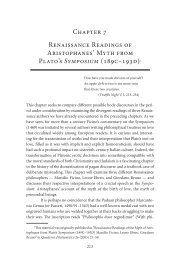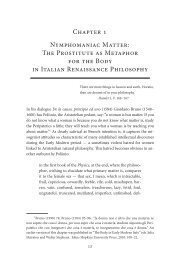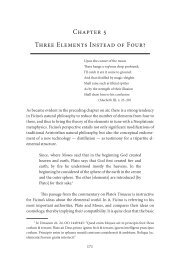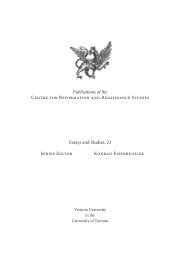Chapter 2 Matter as a Mirror: Marsilio Ficino and Renaissance ...
Chapter 2 Matter as a Mirror: Marsilio Ficino and Renaissance ...
Chapter 2 Matter as a Mirror: Marsilio Ficino and Renaissance ...
Create successful ePaper yourself
Turn your PDF publications into a flip-book with our unique Google optimized e-Paper software.
<strong>Matter</strong> <strong>as</strong> a <strong>Mirror</strong> 105<br />
induces in him a lethal affection for an object that is out of reach; the active gaze<br />
transforms the onlooker into a p<strong>as</strong>sive object of his own desire.<br />
<strong>Mirror</strong>s: Physical Creation<br />
It is precisely this paradoxical quality of reflection <strong>and</strong> imprisonment, a form<br />
of “embodiment without body,” that allows the mirror to become <strong>Ficino</strong>’s<br />
most concise metaphor for the state of matter. Like matter, the mirror willingly<br />
receives <strong>and</strong> embodies any form; hence the paradoxical condition of<br />
matter, namely that it is supposed to remain unchanged in the process of<br />
receiving <strong>and</strong> embodying the myriad forms, is solved. As a tool that embodies<br />
forms without a body, <strong>Ficino</strong>’s mirror is the perfect vehicle to adapt Plotinus’<br />
teaching that matter w<strong>as</strong> the “shadow of a shadow.” In the mirror, actual<br />
bodies seem to vanish <strong>and</strong> hence to become nothing but mere optical illusions.<br />
The equation of mirror <strong>and</strong> matter therefore precludes the <strong>as</strong>sociation<br />
of matter with any sort of tactile perception. This, however, is only half of the<br />
story, because we know that even in the higher <strong>and</strong> highest levels of being<br />
the reflected image retains its material character, albeit in different degrees of<br />
refinement. Towards the lower end in the hierarchy of Creation the objects<br />
which mirrors retain <strong>and</strong> subsequently reflect become incre<strong>as</strong>ingly tangible.<br />
Their relationship to, <strong>and</strong> their connection with women <strong>and</strong> physical procreation<br />
thus becomes even more obvious. A material exchange takes place<br />
between object <strong>and</strong> reflecting surface to such an extent that the reflected object<br />
may even stain the mirror. Not quite unexpectedly, <strong>Ficino</strong> repeats the<br />
Aristotelian story of the menstruating woman who looked at herself in the<br />
mirror <strong>and</strong> the image it reflected <strong>as</strong>sumed the colour of blood.<br />
<strong>Ficino</strong> comes up with this story in his Commentary on the Symposium<br />
when he accounts for love <strong>as</strong> a kind of infectious dise<strong>as</strong>e transmitted by<br />
the visual ray emitted by the eyes:<br />
Aristotle writes that women, when the menstrual blood flows<br />
down, often soil a mirror with bloody drops by their own<br />
gaze. This happens, I think, from this: that the spirit, which is<br />
a vapour of the blood, seems to be a kind of blood so thin that<br />
it escapes the sight of the eyes, but becoming thicker on the<br />
surface of a mirror, it is clearly observed. If this falls on some<br />
less dense material, such <strong>as</strong> cloth or wood, it is not seen, for







